The brand name “Pentax” was established by the Asahi Optical Co. after its great success at the Photokina exhibition in 1956. The company presented a very successful 35 mm SLR camera, the first to feature a pentaprism, a trigger, and many unusual features that aroused general interest. It was called the Asahi Pentax or Pentax AR.
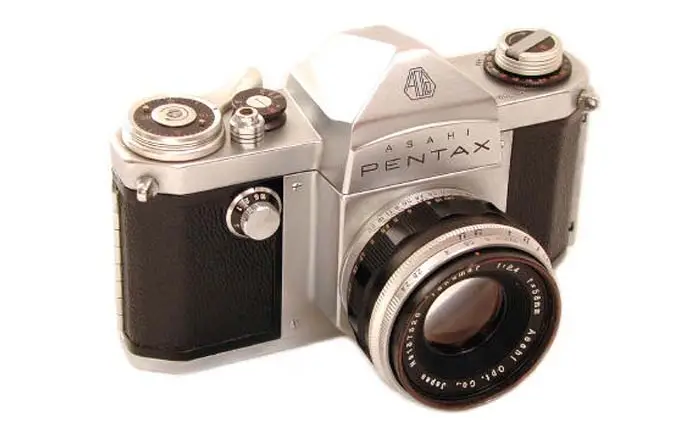
The black Asahi Reptax is considered very rare today.
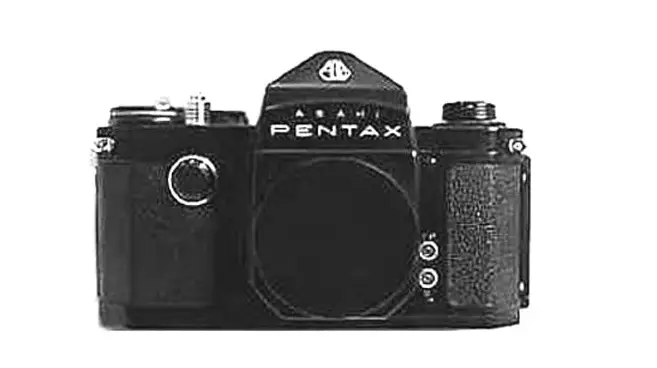
A History of the World’s First 35mm Prism SLR Camera” (Alexander Schultz “Contax S, A History of the World’s First 35mm Prism SLR Camera”), the Pentax name had German roots. Asahi Optical Co. bought the trademark “Pentax” from the East German manufacturer of the Contax S, Zeiss Ikon (Dresden) in 1954.
The “Oriental” Zeiss Ikon never took advantage of the trademark it had invented. In the post-war period, beginning in 1946, there were ongoing disputes between the “Eastern” and “Western” divisions of Zeiss Ikon in Stuttgart concerning the rights to use trademarks and names. This was probably one of the reasons for the sale of the Pentax trademark to third parties.
So the first Pentax from Asahi Optical Co. marked the beginning of a line of cameras that remained popular for years. The main improvement the camera brought was an increase in the diameter of the lens mounting thread from M37mm to M42mm, which also became the standard for Takumar lenses for many years.
A note needs to be made here. Some authors, do not quite rightly refer to the M42 lens thread mount as a Pentax mount. The pioneer of this type of mount belongs to the postwar Contax S, already mentioned, made in 1949 by the East German Zeiss Ikon: Kamera Werkstatten, Dresden
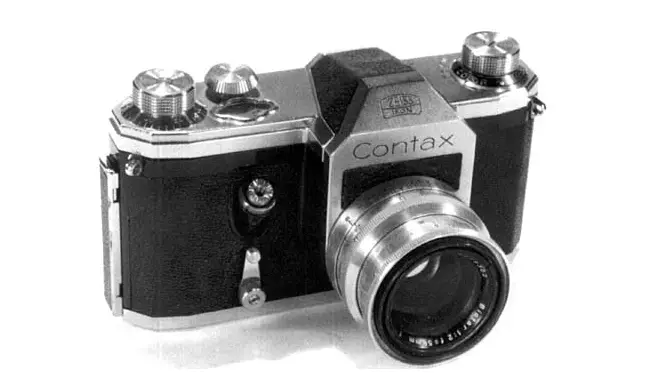
Asahi Optical Co. was the first company to discern a certain convenience in increasing the diameter of lens mounts, and, perhaps guided by the prospect of using German optics, implemented it in its designs. It was followed by numerous manufacturers: Chinon, Cosina, Ricoh, Yashica, of course, Zenith, and many others, not to mention Praktica.
In general, Asahi Optical Co. always generated and often borrowed quite ingenious design and technological ideas, which were not noticed by the competitors, boldly cutting them into their own developments, which were immediately adopted by many manufacturers.
Asahi Optical Co. used a pentaprism viewfinder in the Asahi Pentax camera for the first time instead of the usual mine viewfinder of the time. The first Japanese manufacturer to introduce this innovation in 1953 was the Miranda T (Orion Camera Co.), which in turn borrowed the pentaprism viewfinder from the same Contax S. This idea was patented in 1948-49.
But even before the Photokina exhibition in 1956, Asahi Optical Co. was already well known not only in Japan but also overseas. It’s 35mm. SLR cameras with the Asahiflex IIa/IIb viewfinder had been successfully sold under the name Tower 22/23/24 in the US since the mid-’50s, depending on the modification.
There is another misconception among some authors here. The Asahiflex IIb is often referred to as the first mirror in the world to have a permanent sighting mirror (i.e., one that automatically returns to the sighting position immediately after the shutter is released).
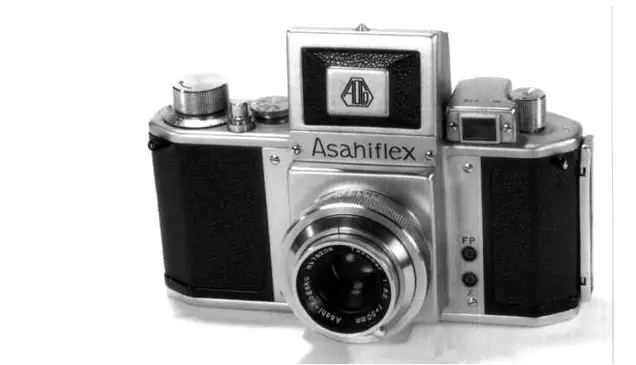
The first “flickering mirror” camera was the Hungarian Duflex (Gammf Works), Budapest in 1947. And to be quite precise the priority of instant mirror return belongs to the British format SLR camera Vanneck of Watson (W. Watson & Sons), London, made as far back as 1890. But in this diversity, we will be interested only in one item mentioned in the name – Asahi Pentax K1000. Since we are briefly acquainted with the abbreviation Asahi Pentax, let’s turn directly to the chosen model, referring back to the progenitors as necessary.
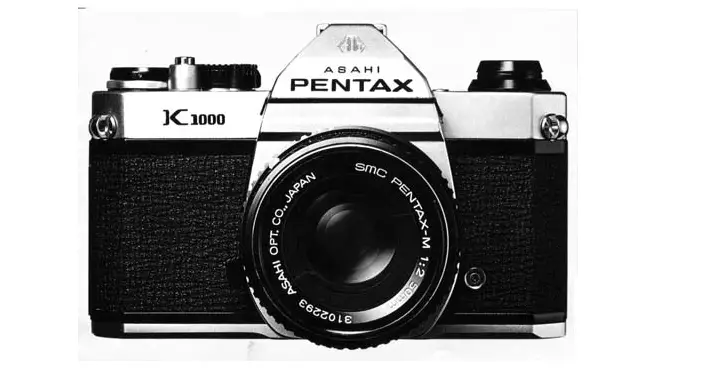
What is Asahi Pentax K1000
K1000 isn’t so ordinary device that the toughest competitors could not, and probably will not be able to show a decent alternative (in the equilibrium price fork of $100-$200). The unusualness of this camera isn’t at all in its saturation fancy electronic wonders.
On the contrary, it’s very simple but executed with such knowledge and love which might be the envy of very sophisticated professional models. This attitude to the design of the camera laid down in the final product steel inflexibility and almost inexhaustible durability. And let’s not forget that the price of the Asahi Pentax K1000 was so affordable that its dizzying success, as it became known, was guaranteed. And the camera was quickly recognized and unmasked.
The Pentax K1000 was born in 1976 and lived a very long photographic life thereafter. The last model rolled off the assembly line in 1997, despite its great demand. Asahi Optical So’s logic in recent years is understandable. It made its main bet on its excellent medium format pro-cameras and autofocus narrow film cameras, mostly of budget class, replacing them today, exclusively with digital consumer products which bring maximum profit. But let’s not judge the manufacturer, it’s led by conjuncture.
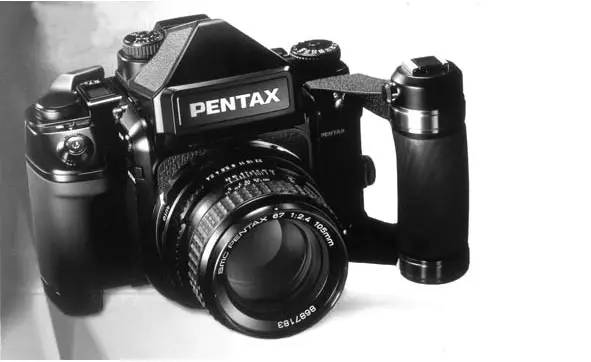
Two-plus decades of sales of the Pentax K1000 did not mean it was structurally stable, and besides, its parents at different times were: Japan, Hong Kong (during its independence), and China. You won’t find the country of the manufacturer on any of the cameras, except for the terse inscription on the back of the top bridge: “Asahi Opt. So. Japan.” Such a solid engraving doesn’t identify the manufacturer in any way. Moreover, the cameras of recent years are also deprived of this inscription, since Asahi Opt. Co. has nothing to do with them anymore. Nevertheless, there are some secrets to deciphering the manufacturer, but we will talk about them later.
The distribution of optics and cameras of Asahi Optical Co. in the U.S. was made by the American company Honeywell. The Pentax cameras, which were made on its order until the mid-1970s, were labeled somewhat differently, for example, Pentax Spotmatic F = Honeywell Spotmatic F, or Pentax ES = Honeywell Pentax ES, etc.
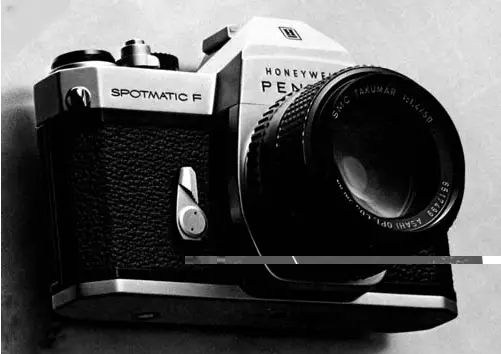
The Pentax K1000 was preceded by three generations of SLR cameras (three lines):
- Asahiflex SLR cameras, with a shaft viewfinder and M37 threaded lens mount;
- Asahi Pentax SLR cameras, with a pentaprism viewfinder and M42 threaded lens mount;
- Pentax Spotmatic SLR cameras, with a pentaprism viewfinder, M42 threaded lens mount, TTL metering and an extended shutter speed range.
Such classification is extremely tentative, but nevertheless gives some idea about the evolution of the equipment.
The Pentax K1000 belongs to the next generation of cameras – the K-series.
In 1973 Asahi Optical Co. gave up threaded optics mounting, despite perfectly tested and proven line of M42 Takumar and Super Takumar lenses. This lineup, along with several zooms, included about seven dozen lenses in the focal length range from 15mm f/3.5 to 1000mm f/8.
The transition to a bayonet mount was a very painful procedure for production. By the mid-1970s Asahi, Optical Co. had already won its rightful place in the top five major manufacturers, and the firm’s engineers clearly felt that such archaic (threading), must be abandoned. The more so because the company’s plans included a system of 35mm. SLR pro-camera, in the design of which there could be no talk about threads. Asahi Optical Co. already had enough experience in creating professional equipment.
As far back as 1969. Back in 1969 (the company wanted to make a presentation to its fans on the occasion of the company’s fiftieth anniversary), a magnificent medium-format SLR pro-camera Pentax 67 left its assembly line and won a lot of sympathies and is repeated even today in the Pentax 67 II modification.
Luck has encouraged, the plan was to create something similar for the narrow format. From 1980 to the 60th anniversary of the founding of Asahi Optical Co., such a camera appeared. The Pentax LX (LX stands for Roman numeral 60), a top-of-the-line camera with serious functionality and system software, was the dream of many photographers. In general, Pentax LX is a separate song, it is uncomfortable to mention it in vain.
So, the K-series is the successor of the Pentax Spotmatic lineup, but with a bayonet lens mount. Of course, all K-series positions were warm-up stages before the creation of the Pentax LX professional instrument, which doesn’t detract from their own charms in the slightest. All K – series models were loaded with various functionalities, probably requiring rigorous testing. So the Pentax KM MD replicated the Pentax Spotmatic F but was equipped with a special lower bridge and motor drive units.
The Pentax KX, while being a fully mechanical camera, nevertheless reflected all exposure information in the viewfinder.
The Pentax K2/K2D MD cameras were somewhat out of place in the K-Series, carrying a heavy electronic load that also required exhaustive testing.
The Asahi Pentax K-1000 mechanical model, with TTL metering, was a sublimate of the Pentax Spotmatic F, which at the time had managed to gain worldwide recognition. The K-1000, stripped of its self-timer and aperture repeater, was almost exactly the same as the Pentax Spotmatic F.
Is Pentax K1000 a good camera?
Perhaps the Asahi Pentax K-1000’s very serious approach to layout and stripping it of virtually all of its secondary functions have made it incredibly durable and long-lasting. The camera has a rugged cast-metal body with duralumin top and bottom panels, enviably resistant to shocks and, sometimes, painlessly enduring accidental falls. Almost simultaneously with the start of mass production of the camera in Japan, part of the production facilities was transferred to Hong Kong.
The new company was completely supplied with components made in Japan, with a few exceptions. The cameras of different parents are almost indistinguishable, both in quality and appearance. The only thing that distinguishes them is the location of the serial number. The “Hong Kong” has it on the bottom panel of the camera, while the “Japanese” has it on the top, between the pentaprism and the rewinding tape.
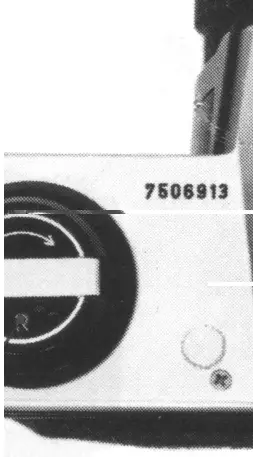
In addition, under the serial number you can see a small round pad, slightly protruding above the plane of the top panel, the brother from Hong Kong, it is absent. According to K1000 fans, both models are indistinguishable in quality and reliability. In the late ’80s, the Pentax K1000 brand was bought by the Japanese company Chinon, which completely placed all production in China.
Taking advantage of the incredible popularity of the camera, they immediately decided to “improve” it by releasing a novelty, which had no longer metal as the top and bottom panels, but plastic. Naturally, the Asahi engraving and Asahi Optical Co. logo disappeared from the pentaprism. and the camera was renamed Pentax K1000, and it was supposed to be sold only in the foreign market.
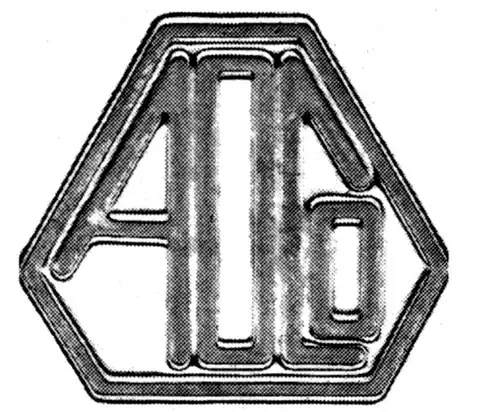
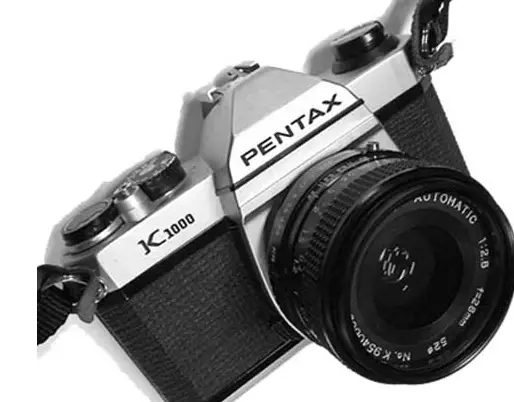
If you have a choice when buying a camera, make your conclusions accordingly, and don’t be surprised that older units, with noticeable signs of wear and tear, may cost somewhat more than the shiny new 1997 K1000.
Pentax K1000 construction explained
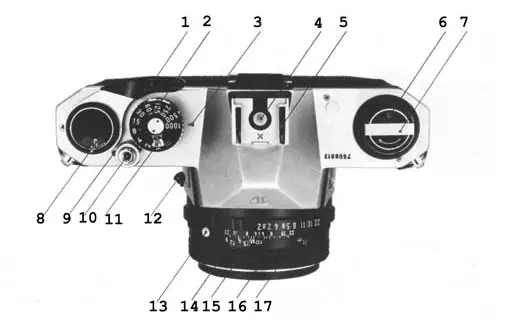
Since it’s ineffective to speak about the subject without illustrating the story, we will embellish the narration with a couple of images of the camera:
1 – the cocking lever, clad in plastic;
2 – the head of the shutter speed changer;
3 – speed indicator;
4 – X – contact of the “hot shoe”;
5 – accessory rails;
6 – rewind head;
7 – rewind tape measure;
8 – frame counter;
9 – cocked shutter indicator;
10 – shutter release;
11 – film sensitivity indicator;
12 – lever for releasing lens mount lock;
13 – spherical protrusion which makes it easier to correctly orient the lens when mounting it on the camera;
14 – the scale of the depth of field;
15 – distance scale;
16 – pointer for apertures and distances;
17 – aperture dial.
The classic arrangement of the main controls and indications will hardly cause any questions, we won’t comment on them in detail, let’s add only a few words.
“Hot shoe” with a central contact admits the use of both “native” automatic (not TTL), or manual flashes, and flash of independent manufacturers (for some reasons of their own safety and security of the camera, domestic illuminators should be avoided). Of course, you can also use TTL – flashes, but only in automatic or manual modes. In addition, on the front panel, to the right of the lens, there is an additional coaxial (PC) connector for an off-camera flash. The maximum sync speed is 1/60 sec. It is marked “60x” on the shutter speed selector head. When using the flash, the 1/60 sec. sync speed must be set manually.
Free of all electronic loads, the shutter can be cocked in one long or several short strokes. The shutter is ready for operation when a red dot (a Pentax innovation) appears next to the shutter button.
The film sensitivity scale is located on the shutter head and is hidden under the speed scale. The range extends from 32 to 3200 ISO. The desired sensitivity must be set in the window on the gear shift head.
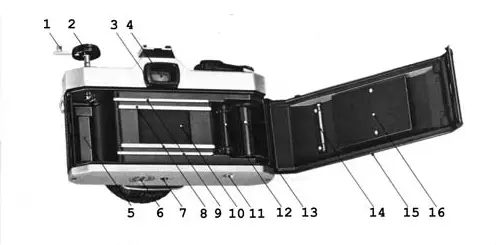
Image of the camera from behind when the cover is folded back.
1 – reverse rewind tape;
2 – rewind head;
3 – guides, for mounting accessories, in particular, diopter correcting lenses;
4 – viewfinder eyepiece;
5 – cassette compartment;
6 – battery compartment;
7 – tripod socket;
8, 9 – film guides;
10 – shutter curtains (rubberized silk);
11 – button for rewinding the film;
12 – “star”;
13 – receiving reel;
14 – film leveling roller;
15 – hinged back cover;
16 – clamping table.
A person picking up the Pentax K1000 for the first time is immediately struck by the unusual brightness and clarity of its viewfinder screen. The screen isn’t removable, combining a frosted Fresnel lens and a circle of micro prisms 3 mm in diameter in the center.
The outer ring, 12 mm in diameter, determines the directionality of the center-weighted measurement. I.e., it accounts for 60% of the 60:40% ratio. The lack of focusing wedges isn’t always a disadvantage. With budget optics, you get rid of the inevitable black spot in the center of the screen. The difficulty in accurately focusing without focusing wedges, which often occurs to visually impaired operators, is offset by the fact that you can operate the viewfinder while wearing eyeglasses.
In addition, Asahi Optical Co. manufactures a range of corrective lenses that fit into guides in the eyepiece frame of the viewfinder. Corrective lenses from other manufacturers, such as Olympus, are also available.
In the center of the right part of the screen, there is a typical TTL indicator for setting the correct exposure. The metering is done with the aperture open. The indicator has “+” and “-” signs (overexposure and underexposure). The right exposure – the hand of the galvanometer occupies a strictly horizontal position.
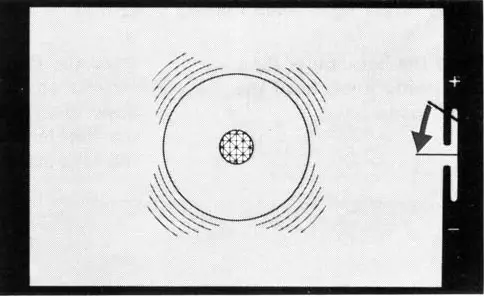
When measuring, if you choose, you can use the aperture or shutter speed priority, i.e. by setting the desired parameter, you can vary the other by setting the hand of the galvanometer to a strictly horizontal position. The gap, in the center of which the arrow is set, is quite wide. With some experience, this can be used to make some corrections to the exposure setting. Let’s say setting the galvanometer arrow at the top edge of the gap is about +1 EV, at the bottom – 1 EV.
The contrast between the black arrow and the white lumen is enough to work with the exposure setting as an indicator in low light conditions.
The Pentax K1000 has no battery monitoring function. You can only assess its performance indirectly by the movement of the galvanometer arrow, by aiming the lens at objects with different degrees of light, or by changing the aperture or shutter speed when you stop at one object.
The power supply has no on/off switch, so it is recommended that the lens be covered when stored to avoid discharging the battery. The no-load current of the measuring circuit is so small that the recommended SR44 or LR44 “tablets” can be used commensurate with the shelf life of the batteries themselves. It should be noted that the nominal capacity of sulfur oxide SR44 batteries is twice that of alkaline LR44 batteries, therefore SR44, or their sulfur oxide analogs are always preferable. And, of course, pay attention to the battery manufacturer.
If you think you will need the camera for a long time, it is better to remove the battery altogether.
You can use many SMS PENTAX lenses on your camera, with “K” mounts from the ultra-wide-angle 15mm/3.5 to the SLR 2000mm/13.5. Independent manufacturers also make a ton of lenses with this mount. I can’t help but mention domestic, very decent lenses with the “K” mount.
Besides, when you use a simple K – M42 adapter (firm or homemade), you get access not only to the line of M42 Takumar and Super Takumar lenses which includes about seven dozen lenses with several zooms but also to the endless quantity of M42 lenses from various manufacturers with an excellent price/quality ratio.
Asahi Optical Co. from 1979 to 1985 periodically produced another modification of the camera in small batches: the Asahi Pentax K1000 SE (Special Edition). The model differed from the main model in color and quality of the leather trim and a slightly modified focusing screen. The Pentax K1000 is a handheld, mechanical, virtually “unkillable” camera that will not only allow you to really master the technique of photography but will reliably accompany you in the most extreme shooting conditions.
Pentax K1000 tech specs
- Type – 35 mm. mechanical SLR camera, with TTL metering at open aperture.
- Frame format – 24 x 36 mm.
- Standard lens – SMC Pentax-M 50mm f/2. K mount – Pentax.
- The shutter is a curtain-slide shutter with horizontal movement of cloth (rubberized silk) shutters in the focal plane.
- Shutter speeds: B, 1 sec. – 1/1000 sec.
- Viewfinder – Non-removable pentaprism. Non-removable viewfinder screen combining a frosted Fresnel lens and a circle of microprisms 3 mm in diameter in the center. Magnification of 0.88x with a 50mm lens set to infinity.
- Information in the viewfinder – Arrow indicator TTL – metering.
- Focus – Manual, on the focusing screen.
- Exposure metering – Center-weighted TTL metering.
- Exposure modes – Setting the shutter speed – aperture, manually by an arrow indicator in the viewfinder.
- Metering range – +3 to 18 EV (at normal temperature with a 50mm/2 lens for ISO 100).
- Flash photography – Flash sync for shutter speeds up to 1/60 sec., no TTL control.
- Film sensitivity range – ISO 20 to 3200, manual setting.
- Film feed – Manual charging, single-frame feed with trigger. Rewind manually.
- Power – 1 cell 1,55.V SR-44 (LR-44).
- Dimensions – 143 х 91,4 х 83 mm.
- Weight – 620 g. (housing only). With the lens 50mm/2 – 790g.
- Frame counter – Resettable, when the cover is opened.






